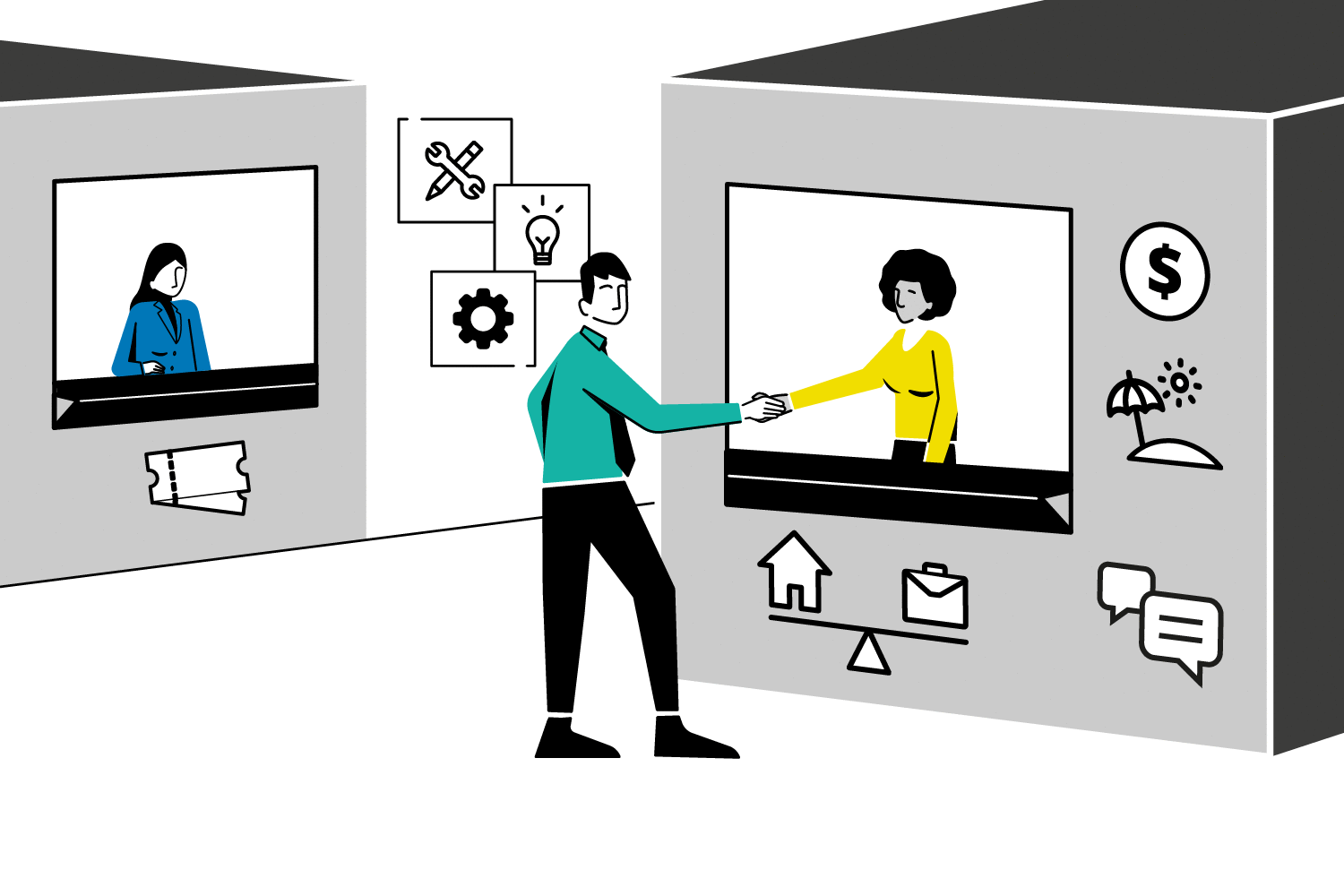Corporate e-learning exploded last year from being an (almost) optional training tool, to the complete “toolbox” that every corporate training program relied on.
Online learning for employees will now remain a key priority as firms tentatively invite employees back to offices, choose a hybrid model, or go fully remote (like Twitter, Shopify and Slack).
In this post, you’ll learn five instructional design secrets for corporate e-learning (also applicable to traditional classroom training) that are not only engaging for employees, but also capable of driving strong business results and lasting behavioral change.
You’ll also see real-world corporate training examples and case studies that have boosted learner engagement, compliance rates and profits (one company created an additional £88,000 per employee).
Table of contents:
Pick corporate e-learning software that grows with you
Are you prepared to handle sudden change?
Choosing adaptive learning management and e-learning software is no longer a nicety. As the indelible events of 2020 have shown, waves of disruption and change can strike at any moment.
In an instant, companies scrambled from in-person and instructor-led training to e-learning and remote training. Usage of e-learning tools and learning management systems skyrocketed as almost every organization on the planet made the mandatory leap to digital training for its employees.
Deloitte Accountancy, one of the four largest accounting organizations in the world, focused on ensuring that its accountancy experts had the right skills to nurture healthy, lasting relationships with clients when relying on digital communications.
This initiative directly improved Deloitte’s customer experience as consultants were able to precisely meet different customer expectations and needs throughout different stages.
In the throes of the pandemic, Monash health the largest public health service in Victoria, Australia, urgently needed to deploy Monash Health’s PPE training to support infection control and safety protocols for 70,000 residential care workers.
Thanks to their adaptable learning platform and responsive developers, they developed an accessible platform that fast-tracked a six-week implementation into just five days to tackle rising COVID rates in Victoria.
As a result, thousands of residential and aged care workers were able to quickly access online training for COVID-19 PPE and infection control protocols.
These two stories (among many others) drive a key point home:
An agile culture, powered by a people-first L&D strategy and adaptive learning technology to support it, will pay game-changing dividends when waves of unexpected change strike.
Unfortunately, identifying truly adaptive corporate learning technology isn’t easy. Especially when many vendors market the ability to change logos and font colors as “adaptability.”
True adaptability and customizability let you mold functionality to meet your unique and growing needs. True adaptability is also about powering necessary change without disrupting your existing workflows and processes.
Design transformative training by solving corporate challenges
It’s not unusual to hear about learning or instructional design projects taking 3, 6, 12 months or more to be ready for delivery.
It is also not unusual to hear how training fails to make a measurable impact or completely misses the mark due to business or employee needs moving on.
You can avoid these common pitfalls by taking a problem-first approach to course creation and instructional design.
Using training to identify and solve key challenges will ensure that the training you create positively impacts business results—regardless of whether you deliver it digitally through an e-learning course or in-person via instructor-based learning.
(When sales grow, customer satisfaction rises and onboarding times decrease thanks to the training produced by L&D, securing a bigger budget and proving that L&D is supporting your organization becomes easier.)

With over 200 stores and 2,000 employees, Nobia is one of the largest kitchen retailers in the UK. Unfortunately, the companies onboarding process and face-to-face induction training harmed the organization’s profitability—staff turnover was high and training was disorganized.
Line managers, for example, manually produced reports and awarded certificates. Training for employees was also inconsistent and varied from store to store.
Identifying the business challenges and bottlenecks, Nobia set clear goals for their corporate e-learning program. These included goals such as:
-
Improving employee retention rates
-
Providing employees with consistent training, messaging and support
-
Reducing time to competency and improving onboarding for new starters
Launching their learning platform to fix key business challenges fostered game-changing results for Nobia. Within 6 months:
-
Time-to-competency for new staff members was reduced by 67% (from 5 months – 7 weeks)
-
An additional £88,000 per employee was generated by the three-month time-to-competency saving and its direct impact on sales turnover
-
Staff retention increased by 11%
You can respond quickly to business challenges (and make e-learning hyper-relevant) by taking a similar diagnostic approach to developing training material.
Start by focusing on the extremes. Identify vital knowledge and skills gaps in areas of the business (or among employees) that perform poorly.
Then, investigate areas of the business (and employees) that perform exceptionally well to share best practices and technical expertise that shortcut learning curves.
Quite often, you’ll find that there’s a missing piece of information or small tip from a senior employee that once documented and shared, will swiftly solve time-consuming bottlenecks and inefficiencies in a cost-effective manner.
Example: Declining compliance rates when engineering train parts
This example focuses on physical engineering parts, but you can easily translate this into your own sector, product or service context.
-
There’s a spike in intranet searches for the term “CBC08 bracket frozen”
(The CBC08 bracket, in this example, is a part used to connect trains and has critical safety implications if not functioning as intended.)
-
L&D find and interviews senior engineers who work with the CBC08 bracket and discover the remedial knowledge that others are need
-
An article & visual guide on how to unfreeze the CBC08 bracket is created and shared immediately
-
Engineers can now unfreeze the CBC08 bracket. As a result, compliance rates increase and production rates improve
Strip your corporate e-learning program down to the essentials
Expanding on the point above about working backward from business objectives, don’t waste time on ineffective or irrelevant content.
Like you, your learners are people with busy lives, personally and professionally. Discretionary time is often short and irregularly available. And casually adding more content to their required training will only add to their stress levels without generating any meaningful impact.
Be brutally efficient and provide targeted support that will add value to the organization but also be valued by the individual. This means covering the basics and keeping things well-structured and relevant.
Use audiences to assign specific training to groups, learning pathways for complex skills and competencies, show employees their learning progress and use reports to track engagement and identify drop-offs in attention.
Support retention with powerful instructional design principles
Have you ever endured a training session or e-learning course that had you clock-watching, waiting for it to end?
That’s the exact opposite of how you want your employees to feel.
To boost retention and create content that employees enjoy, follow these modern instructional design tips and teaching techniques:
1. Spice up the delivery of your content with engaging video

Video is an engaging medium because it facilitates self-paced learning and increases the effectiveness of workplace learning.
That being said, creating e-learning videos takes considerable time and effort. You can streamline the process by hiring content developers or opting for different instructional formats such as:
-
“Talking head” videos
-
Whiteboard animations
-
Simple screen sharing
-
B-roll footage
-
And animated graphics
2. Encourage ideas to “stick” with metaphors, analogies and comparisons
People learn by anchoring new information to existing ideas or concepts.
This makes teaching devices such as metaphors, similes, analogies and comparisons notably effective for enhancing engagement and retention when designing corporate training courses.
For example, I could explain the importance of using SEO to get more traffic by talking about things like keyword traffic, competition density and searcher intent.
If you’re not familiar with these concepts, you may (or may not) understand the point, but it probably won’t “stick.”
If, however, I say that creating more web pages to capture traffic is like fishing—you’re throwing out more fishing rods (webpages) to passively attract fish (traffic)—it’s a more memorable example.
3. Boost retention with the Inverted Pyramid
In journalism, the Inverted Pyramid is a story structure requiring the most important piece of information to be presented first.

You should apply this structure to the content you create, especially in a corporate training context, where employees have limited time and energy to focus on absorbing abstract concepts and supportive information.
This doesn’t mean glossing over important technical details. It’s about prioritizing the delivery of practical, job-relevant information and immediately establishing the who, when, where, why and how.
4. Inject an evocative human touch with storytelling
Aiming to test the power of stories, journalist Rob Walker hired a group of writers to create emotionally provocative stories about unwanted, cheap thrift store items.
He then placed the items on eBay with the story in the description.
The results were shocking: $128.74 worth of abandoned thrift items sold for over $3000 dollars. An overall value increase of over 2,700%.
Storytelling is an underrated tool for not only teaching, but also connecting with people. If you’re aiming to emphasize a specific idea or the importance of following safety protocols, for example, a narrative structure beats linearly listing abstract steps behind a process.
So don’t be afraid to add a human voice to your content and make it warmer and more inviting. A simple way to do this is to provide realistic examples or stories with plot elements (challenges, dangers, progress etc.) to make a point more memorable or relatable.
5. Prioritize unique e-learning content to inspire true change
Efficiency doesn’t necessarily translate to effectiveness.
Avoid slipping into the trap of relying on endless pages of drag-and-drop activities to apply gamification and encourage engagement. This style might make it easier to complete modules and courses, but it fails to reinforce content and generate curiosity.
As a result, such a style lends itself poorly to long-term behavioral change, buy-in from employees and on-the-job awareness.
If you have the budget, you should also consider reducing your use of standard templates, clip art and other easily available media assets that are designed for efficiency, not effectiveness.
Instead, think creatively about the topic and associated behaviors you are looking to instill—it’s unlikely that you’ll find standard authoring tool templates working for you.
Bear in mind that employees will also crave a balance between familiarity and variety—both in terms of media and presentation—so if all your learning modules look and feel exactly the same, retention and engagement rates will suffer.
Author bio: Hassan Uddeen is a freelance content strategist and SEO specializing in content campaigns for B2B, HR and SaaS companies


